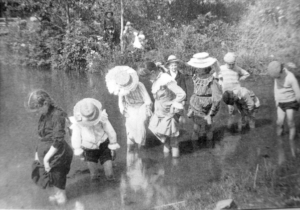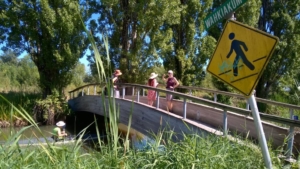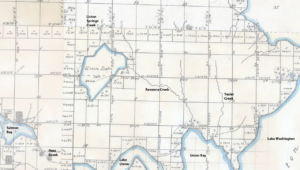FECO’s Watershed and its History
Eight walkers joined Nancy Helm to learn about the watershed that FECO drains into and to hear about the people who historically used the Ravenna Creek area. Participants added to the history walk with information about native plants and stories of the old landfill in the Union Bay area.
Nancy explained that a watershed is a drainage. (It doesn’t mean that the rain at FECO ends up in our shed!) When it rains at FECO, the rain drops sink into the groundwater or become part of runoff and eventually end up in Lake Washington.
for work parties
Sun. Oct 21, 2-4, FECO Cider Fest
Please email to volunteer
freewayestatescommunityorchard@gmail
The current landowners track the watersheds to measure things like pollution and surface water infrastructure management. The Indigenous Peoples who lived here before colonization, being place-based, used the streams that feed the lakes as a means of navigation, as a convenient place to live, and as a fishing resource. (There are archaeological records of tools and people managing the land 4,000 years ago – University of Washington Burke Museum archives). In the late 1800s, when it became illegal for Native Americans to live in Seattle, new owners of Ravenna Park made major changes.
 Nancy explained that Ravenna Creek was the drainage from Green Lake, plus all the neighborhoods that feed Green Lake. You could practically swim in the Creek in the late 1800s and the surrounding old growth forest kept the creek cool.
Nancy explained that Ravenna Creek was the drainage from Green Lake, plus all the neighborhoods that feed Green Lake. You could practically swim in the Creek in the late 1800s and the surrounding old growth forest kept the creek cool.
Green Lake no longer feeds the Creek because, in 1911, it was lowered to create Green Lake Park. We walked past the west edge of Ravenna Park where Nancy pointed out some seeps and springs which now provide fresh water for the Creek. There were some 40 springs in the early 1900s but the City of Seattle altered the landscape and most of the springs disappeared or were capped. Salmon, plant and animal diversity decreased as a result of the loss of the larger waterway.
By 1948, Seattle Parks had cut down all of the old growth trees and the creek was diverted to a storm  gate, emptying into the West Point Sewer Treatment Plant. Once storm water overflow volume became too much for the City, the Ravenna Creek Alliance fought to route Ravenna Creek back to Lake Washington.
gate, emptying into the West Point Sewer Treatment Plant. Once storm water overflow volume became too much for the City, the Ravenna Creek Alliance fought to route Ravenna Creek back to Lake Washington.
As we walked, we noticed many common native plants such as salmonberry, trailing blackberry, toothed dock, sword fern, common snowberry, salaal and Oregon grape, to name a few.
 Ravenna Creek flows underground into a pipe at the east end of Ravenna Park. We observed the other end of that pipe on NE 45th Ave, just south of University Village. Participants noted the difference in the quality of the water at this location, versus the quality of the water where it is daylighted in Ravenna Park. The walk concluded where the mouth of Ravenna Creek flows to Lake Washington.
Ravenna Creek flows underground into a pipe at the east end of Ravenna Park. We observed the other end of that pipe on NE 45th Ave, just south of University Village. Participants noted the difference in the quality of the water at this location, versus the quality of the water where it is daylighted in Ravenna Park. The walk concluded where the mouth of Ravenna Creek flows to Lake Washington.
The Ravenna Creek walk is a project of a FECO Coast Salish Solidarity subcommittee that is learning how Western minds have been trained and how different frameworks of thinking and being might improve our relationships with all beings.
Ruth
http://www.fact-index.com/u/un/university_slough.html
https://sustainability.uw.edu/blog/2015-11/ravenna-parks-complicated-past


Great job!
Joan Davis
Thanks. Ruth!
Interesting article.